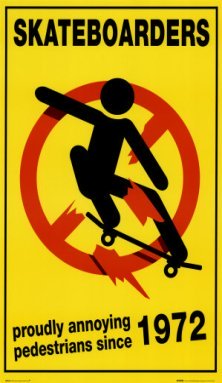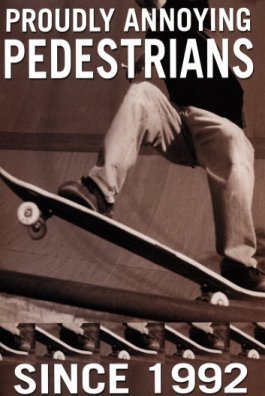The Skateboarders Edge, Why Skateboarding
Culture is Still Cutting Edge after 50 Years
 by C. Pless
by C. Pless
The DNA of Skateboarding
Anti-establishment. Rebel. Stoner. Anarchist. Nonconformist. These are the so-called negative attributes of the skateboarding world. Aggressive. Independent. Free thinkers. Street smart. These are the so-called positive attributes of the skateboarding world.
There is more to it than that, though. In reality skateboarders are survivors and signify a way of life that has managed to remain true to its roots for nearly 50 years. Skateboarding has defied authority and mainstreaming even though the groms of today are the grandchildren or even great grandchildren of skateboarding pioneers.
In every other sport, the pioneers, who started out as young and rebellious, such as auto racing, took over their sport and never let go. In never letting go they redirected their sports into becoming mainstream establishments of capitalism entertainment conglomerates. Just to compete in such a sport one has to conform to rules and standards owned and controlled by people who no longer compete. Skateboarding has resisted this largely because of what the sport is about. Skateboarding is about style, creation, and attitude. These aren’t things that can be controlled by book of rules and a referee. The world of skateboarding largely rejects rules and controls.
Skateboarders are Survivors
In the beginning of every skater generation there are millions of posers wandering around and falling down all over the skate parks on their scooters, boards, and bikes. Trailing behind these tots on wheels are millions of over protective parents who guard their little posers from groms and skaters as though they were wandering in the jungle. Some of them never let their little ones come back, and those that do escape their parents and do come back face the DNA of skateboarding. Natural selection starts to take over.
The first to go are the ones who realize that skateboarding means commitment. They graduate to collecting and buying free stickers and their skateboards end up in a closet or under the bed. The closest they come to actually skateboarding is a video game.
The next to go are the ones who discover that skateboarding means getting hurt. They start looking for less painful hobbies and stick their skateboards in a prominent corner of their room where it is buried under all the other things they got hurt doing.
The thinning ranks of skaters are now thinned by choices. Scores of would be skaters are forced into making choices between sports. Baseball, soccer, football, hockey, and basketball (and in some places lacrosse) have hordes of parents, coaches, and conformist organizations that demand total allegiance to their sports. Many have become year round sports and have coaches that demand athletes don’t participate in any other sport at all.
The ranks thin out by personal styles of the remaining skateboarders, too. Skateboarders that are all about being the fastest inevitably get on bikes, move on to motorcycles or cars and eventually migrate out of the skating world. Next time they are seen again it as at NASCAR where they grow beer bellies and listen to country music. There new friends would be amazed that any of them ever even knew what an ollie was.

Pressure to conform becomes even stronger as the groms become teens because at this time because many of the surviving groms parents suddenly realize that skateboarding is full of “bad influences.” This is when the difference between Prep and Skater takes place. Suddenly kids go to the mall and they have to choose between Zumiez or Abercrombie and Fitch and they end up labeled for the rest of their school years. What are left are the nonconformists who are the cultural identity of skateboarding.
Next: Part 2, The Anti Mainstream Culture of Skateboarding





